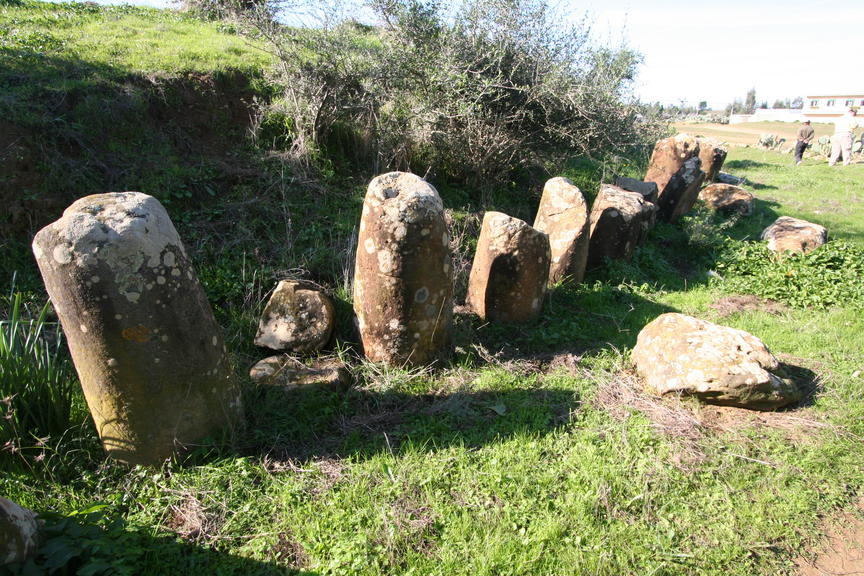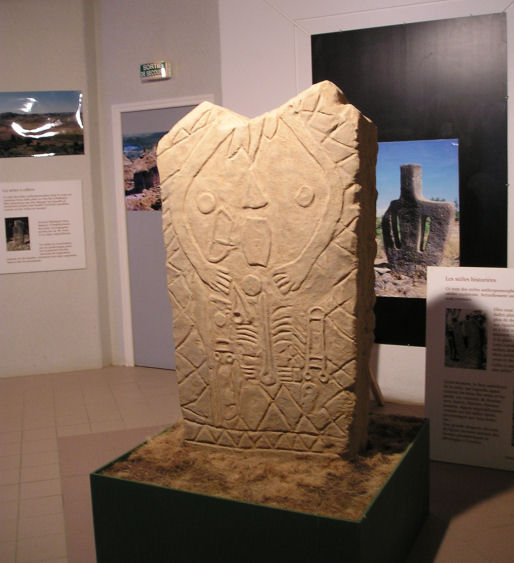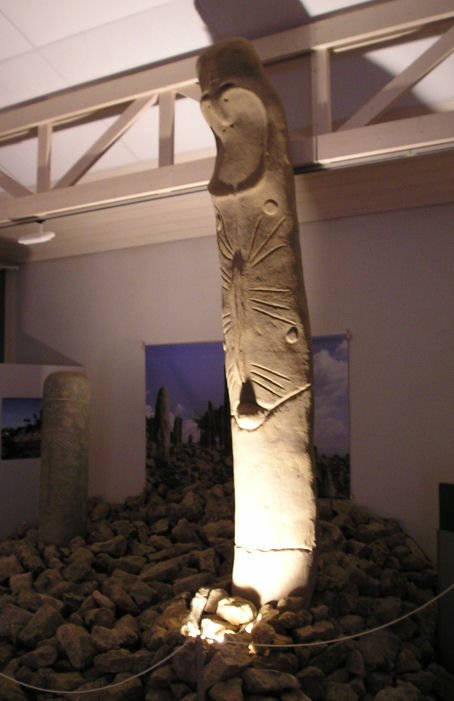Post by anansi on May 16, 2011 7:46:21 GMT -5
This thread takes on a trip to megalithic sites in Africa some to do with the stars some not please feel free to add your own finds.
Zimbabwe
Mysterious ruins in Zimbabwe, nearly brushed this week by the shadow of a total solar eclipse, once served as an astronomical observatory to track eclipses, solstices and an elusive exploding star, a South African scientist said.
The Great Enclosure in the archaeological site of Great Zimbabwe, a crumbling ring of stone walls and platforms about 250 meters in circumference, was thought to have been a palace complex for regional rulers some 800 years ago.
But Richard Wade of the Nkwe Ridge Observatory thinks that the enclosure was used in a similar capacity as the much older Stonehenge in Great Britain.
The arrangement of the walls, the complicated symbols on stone monoliths and the position of a tall tower suggest that medieval Zimbabweans used the complex to track the moon, sun, planets and stars for centuries.
"The importance of Great Zimbabwe is that it was the capital of the only known sub-Saharan African Empire that lasted almost 1,000 years. Everyone in southern Africa somehow relates to this nucleus cultural complex," Wade said.
Several of the stone monoliths, for example, line up with certain bright stars in the constellation Orion as they rise on the morning of the shortest day of the year, the winter solstice.
Another contains markings that coincide with orbital patterns of Earth and Venus, which could be used to forecast eclipses, Wade said.
In his most controversial position, Wade suggests that a tower at the complex, whose purpose has baffled historians, was probably built to observe an exploding star in roughly 1300 AD.
"This large conical tower in the great enclosure stands directly in line with the rising supernova remnant when seen from the observation platform and court area of the time," Wade wrote in a paper to be submitted to the journals Science and Scientific American.
"They requested that I send the work on completion," he said. "I have been peer reviewed now for almost four years and only recently have I received a nod from the South African science community."
Modern telescope observations indicate that a supernova lit up the sky at approximately the same time. Historic records make no mention of it, an omission that does not surprise Wade since the dying star appeared over the Southern Hemisphere, which at the time had virtually no literate cultures.
But oral legends in the region lend credence to the supernova idea, Wade said. The Sena people of Zimbabwe hold that their ancestors migrated from the north by following an unusually bright star in the southern skies.
articles.cnn.com/2002-12-05/tech/zimbabwe.observatory_1_supernova-forecast-eclipses-star?_s=PM:TECH


Wassu Stone Circles Senegal

Between Wassau and Kau-Ur lay the mysterious Stone Circles. These circles to this day remain an anthropological and archeologically puzzle. Experts think that the stone circles are the only remaining
evidence of an old unknown African civilisation.
The circles remind us a bit of Stonehenge in Scotland, but it is not certain if these circles are in line with the solar circulation.
No archaeological excavations have been made because the Village Chiefs think a curse will descent on everybody if the holy circles are disturbed.
www.lamininthegambia.com/english/wassu_-_stone_circels.html
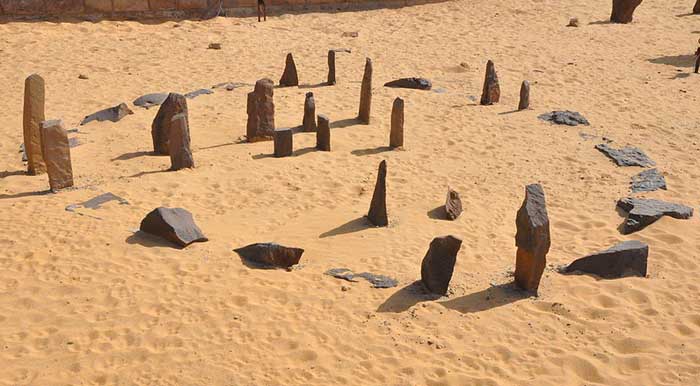
On the dusty planes of Nabta in southern Egypt, ancient nomads stopped for a short time to bask in the Nile's intense summer sunshine. Beneath the Tropic of Cancer, they erected stones that cast no shadows, aligned with the rising and setting of the sun.
Location:
A large basin known as Nabta Playa, located about 100 km west of Abu Simbel near the Egyptian-Sudanese border
Latitude 22 32 00N. Longitude: 30 42 00E
Alignments:
The site, known as Nabta, is between 6,000 and 6,500 years old, or about 1,000 years older than Stonehenge. The Nabta site was discovered several years ago by a team led by Southern Methodist University anthropology Professor Fred Wendorf. It appears to have been constructed by nomadic cattle-herders living in southern Egypt. The complex isn't circular like Stonehenge. It is .8 miles wide and 1.8 miles long. It includes 10 slabs some 9 feet high, 30 rock-lined ovals, nine burial sites for cows, each under a pile of 40 to 50 rocks weighing up to 200 or 300 pounds apiece, and a "calendar circle" of stones. Many of these features line up in five radiating lines, one of them running east-west. The calendar circle is a 12-foot-wide arrangement of slabs about 18 inches long, most of them lying down.
Because Nabta lies near the Tropic of Cancer, the noon sun is at its zenith about three weeks before and three weeks after the summer solstice, preventing upright objects from casting shadows. "These vertical sighting stones in the circle correspond to the zenith sun during the summer solstice," said Malville, an archeoastronomer at the University of Colorado. "For many cultures in the tropics, the zenith sun has been a major event for millennia." Two pairs of upright stones stand directly across the circle from each other, defining a view that would have displayed sunrise at the summer solstice. The circle also contains two other pairs of standing stones that defined a north-south view.
webcache.googleusercontent.com/search?q=cache:http://sunearthday.nasa.gov/2005/locations/egypt_stone.htm
Ng'amoritung'a Kenya![]() [/img]
[/img]
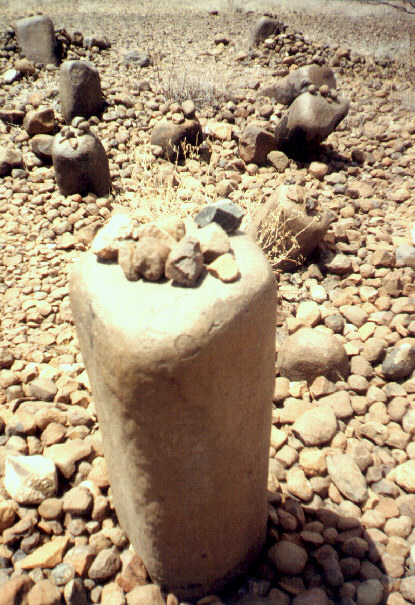

Namoratunga II is a site of 19 magnetic (Soper 1982, Doyle and Wilcox 1986) stone pillars cut with 4 sides and a slanted top and petroglyphs on them.
Located near Lake Turkana in Kenya, Namoratunga means stone people in the local language. The site itself has not been dated, but similar petroglyphs at a burial site, Namoratunga I 100km to the south of it have caused archaeologists to give it the same date as that site - 300BC.
It was discovered by B.M. Lynch and L.H Robbins in1978 and later studied by many, including L.R Doyle and Soper R.
Lynch and Robbins put forth initial arguments that the pillars were astronomically aligned (Krupp, 1983 pg 170-171). Over the years the measurements and alignments of the pillars have been remeasured and reassessed. The pillars today are suggested to be aligned to the 7 stars of the Borana Calendar of the Cushite people whose positions in the sky mark the months when they rise at the same position on the horizon with the phrases of the moon. The seven stars or star groups in order are Triangulum, Pleiades, Aldebarran, Belletrix, Orion, Saiph, and Sirius. Soper,Doyle and Edward Frank found in an 1983 expedition to the site that there were "25 two-pillar alignments with the 300 B.C. eastern rising positions of the Borana calendar stars". To prove that the alignments were not random, they generated 10,000 random star alignments, and only 0.41% of them had 25 or more random alignments. Thus it seems highly unlikely that the alignments were random.
library.thinkquest.org/C0118421/africakenya.htm
South Africa
l

The Johan Heine Stone Calendar (affectionately called Adam’s Calendar) has been dated by astronomer Bill Hollenbach to be around 75,000 years, based on the movement of the peoples in southern Africa and the emergence of rock art during that period. But it could in fact be even older – dating back to the dawn of Homo sapiens some 250,000 years ago.
The carved edge can be clearly seen, resulting in a sharp edge to cast a clear shadow on the flat calendar rock. The wider monolith became the calendar on which days and weeks were marked as the movement of the sun stretched perfectly from one edge to the other, left to right, and than back again.
www.makomati.org/pages/the-ruins.php
The dates on this is very controversial at 75,000 yrs old
Zimbabwe
Mysterious ruins in Zimbabwe, nearly brushed this week by the shadow of a total solar eclipse, once served as an astronomical observatory to track eclipses, solstices and an elusive exploding star, a South African scientist said.
The Great Enclosure in the archaeological site of Great Zimbabwe, a crumbling ring of stone walls and platforms about 250 meters in circumference, was thought to have been a palace complex for regional rulers some 800 years ago.
But Richard Wade of the Nkwe Ridge Observatory thinks that the enclosure was used in a similar capacity as the much older Stonehenge in Great Britain.
The arrangement of the walls, the complicated symbols on stone monoliths and the position of a tall tower suggest that medieval Zimbabweans used the complex to track the moon, sun, planets and stars for centuries.
"The importance of Great Zimbabwe is that it was the capital of the only known sub-Saharan African Empire that lasted almost 1,000 years. Everyone in southern Africa somehow relates to this nucleus cultural complex," Wade said.
Several of the stone monoliths, for example, line up with certain bright stars in the constellation Orion as they rise on the morning of the shortest day of the year, the winter solstice.
Another contains markings that coincide with orbital patterns of Earth and Venus, which could be used to forecast eclipses, Wade said.
In his most controversial position, Wade suggests that a tower at the complex, whose purpose has baffled historians, was probably built to observe an exploding star in roughly 1300 AD.
"This large conical tower in the great enclosure stands directly in line with the rising supernova remnant when seen from the observation platform and court area of the time," Wade wrote in a paper to be submitted to the journals Science and Scientific American.
"They requested that I send the work on completion," he said. "I have been peer reviewed now for almost four years and only recently have I received a nod from the South African science community."
Modern telescope observations indicate that a supernova lit up the sky at approximately the same time. Historic records make no mention of it, an omission that does not surprise Wade since the dying star appeared over the Southern Hemisphere, which at the time had virtually no literate cultures.
But oral legends in the region lend credence to the supernova idea, Wade said. The Sena people of Zimbabwe hold that their ancestors migrated from the north by following an unusually bright star in the southern skies.
articles.cnn.com/2002-12-05/tech/zimbabwe.observatory_1_supernova-forecast-eclipses-star?_s=PM:TECH


Wassu Stone Circles Senegal

Between Wassau and Kau-Ur lay the mysterious Stone Circles. These circles to this day remain an anthropological and archeologically puzzle. Experts think that the stone circles are the only remaining
evidence of an old unknown African civilisation.
The circles remind us a bit of Stonehenge in Scotland, but it is not certain if these circles are in line with the solar circulation.
No archaeological excavations have been made because the Village Chiefs think a curse will descent on everybody if the holy circles are disturbed.
www.lamininthegambia.com/english/wassu_-_stone_circels.html

On the dusty planes of Nabta in southern Egypt, ancient nomads stopped for a short time to bask in the Nile's intense summer sunshine. Beneath the Tropic of Cancer, they erected stones that cast no shadows, aligned with the rising and setting of the sun.
Location:
A large basin known as Nabta Playa, located about 100 km west of Abu Simbel near the Egyptian-Sudanese border
Latitude 22 32 00N. Longitude: 30 42 00E
Alignments:
The site, known as Nabta, is between 6,000 and 6,500 years old, or about 1,000 years older than Stonehenge. The Nabta site was discovered several years ago by a team led by Southern Methodist University anthropology Professor Fred Wendorf. It appears to have been constructed by nomadic cattle-herders living in southern Egypt. The complex isn't circular like Stonehenge. It is .8 miles wide and 1.8 miles long. It includes 10 slabs some 9 feet high, 30 rock-lined ovals, nine burial sites for cows, each under a pile of 40 to 50 rocks weighing up to 200 or 300 pounds apiece, and a "calendar circle" of stones. Many of these features line up in five radiating lines, one of them running east-west. The calendar circle is a 12-foot-wide arrangement of slabs about 18 inches long, most of them lying down.
Because Nabta lies near the Tropic of Cancer, the noon sun is at its zenith about three weeks before and three weeks after the summer solstice, preventing upright objects from casting shadows. "These vertical sighting stones in the circle correspond to the zenith sun during the summer solstice," said Malville, an archeoastronomer at the University of Colorado. "For many cultures in the tropics, the zenith sun has been a major event for millennia." Two pairs of upright stones stand directly across the circle from each other, defining a view that would have displayed sunrise at the summer solstice. The circle also contains two other pairs of standing stones that defined a north-south view.
webcache.googleusercontent.com/search?q=cache:http://sunearthday.nasa.gov/2005/locations/egypt_stone.htm
Ng'amoritung'a Kenya

Namoratunga II is a site of 19 magnetic (Soper 1982, Doyle and Wilcox 1986) stone pillars cut with 4 sides and a slanted top and petroglyphs on them.
Located near Lake Turkana in Kenya, Namoratunga means stone people in the local language. The site itself has not been dated, but similar petroglyphs at a burial site, Namoratunga I 100km to the south of it have caused archaeologists to give it the same date as that site - 300BC.
It was discovered by B.M. Lynch and L.H Robbins in1978 and later studied by many, including L.R Doyle and Soper R.
Lynch and Robbins put forth initial arguments that the pillars were astronomically aligned (Krupp, 1983 pg 170-171). Over the years the measurements and alignments of the pillars have been remeasured and reassessed. The pillars today are suggested to be aligned to the 7 stars of the Borana Calendar of the Cushite people whose positions in the sky mark the months when they rise at the same position on the horizon with the phrases of the moon. The seven stars or star groups in order are Triangulum, Pleiades, Aldebarran, Belletrix, Orion, Saiph, and Sirius. Soper,Doyle and Edward Frank found in an 1983 expedition to the site that there were "25 two-pillar alignments with the 300 B.C. eastern rising positions of the Borana calendar stars". To prove that the alignments were not random, they generated 10,000 random star alignments, and only 0.41% of them had 25 or more random alignments. Thus it seems highly unlikely that the alignments were random.
library.thinkquest.org/C0118421/africakenya.htm
South Africa
l


The Johan Heine Stone Calendar (affectionately called Adam’s Calendar) has been dated by astronomer Bill Hollenbach to be around 75,000 years, based on the movement of the peoples in southern Africa and the emergence of rock art during that period. But it could in fact be even older – dating back to the dawn of Homo sapiens some 250,000 years ago.
The carved edge can be clearly seen, resulting in a sharp edge to cast a clear shadow on the flat calendar rock. The wider monolith became the calendar on which days and weeks were marked as the movement of the sun stretched perfectly from one edge to the other, left to right, and than back again.
www.makomati.org/pages/the-ruins.php
The dates on this is very controversial at 75,000 yrs old




